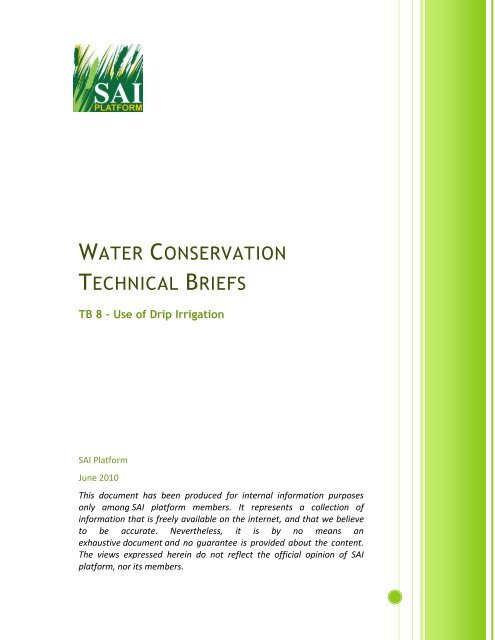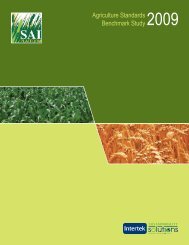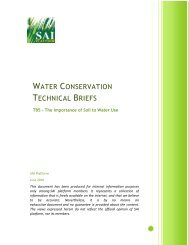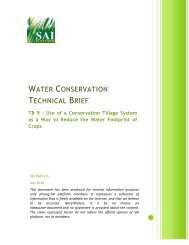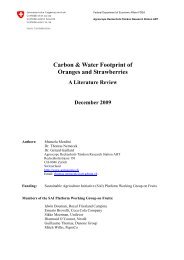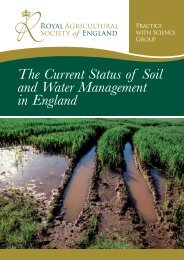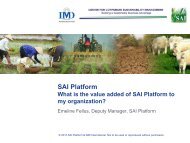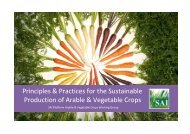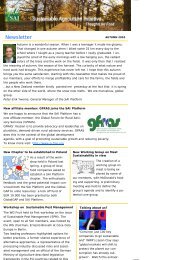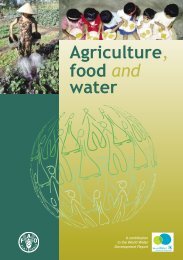Download file - SAI Platform
Download file - SAI Platform
Download file - SAI Platform
You also want an ePaper? Increase the reach of your titles
YUMPU automatically turns print PDFs into web optimized ePapers that Google loves.
WATER CONSERVATION<br />
TECHNICAL BRIEFS<br />
TB 8 – Use of Drip Irrigation<br />
<strong>SAI</strong> <strong>Platform</strong><br />
June 2010<br />
This document has been produced for internal information purposes<br />
only among <strong>SAI</strong> platform members. It represents a collection of<br />
information that is freely available on the internet, and that we believe<br />
to be accurate. Nevertheless, it is by no means an<br />
exhaustive document and no guarantee is provided about the content.<br />
The views expressed herein do not reflect the official opinion of <strong>SAI</strong><br />
platform, nor its members.
TB 8 – Use of Drip Irrigation<br />
WATER CONSERVATION<br />
TECHNICAL BRIEFS<br />
TB 8 - Use of Drip Irrigation<br />
Adopting more efficient techniques, such as using drip irrigation systems, can help<br />
ensure that farmers use water more efficiently. Drip irrigation systems normally<br />
place the water directly into the soil, or onto the soil surface, reducing the risk of<br />
runoff and thereby improving water application efficiency. Drip irrigation systems<br />
can be classified as traditional drip irrigation system, subsurface drip irrigation and<br />
low cost alternative systems. For a well designed, installed, and maintained<br />
irrigation system, application efficiencies can be up to 90 % for the area irrigated.<br />
The structure of the technical brief is as follows: Sections 1 and 2 describe drip irrigation<br />
systems. Section 3 sets out the key issues needed to work out before the farmer decides<br />
whether a drip irrigation system is right for a particular farm. Section 4 presents a stepby-step<br />
decision tree for the sustainable improvement of water efficiency at a farm<br />
level. Section 5 outlines two case studies on drip irrigation implementation in Almeria,<br />
Spain and Greece. Section 6 outlines a set of KPI to monitor drip irrigation efficiency.<br />
Finally, Section 7 recommends some further reading.<br />
Contents<br />
Section 1: What is Drip Irrigation? ...................................................................................... 2<br />
Section 2: Drip Irrigation systems ....................................................................................... 2<br />
Section 3: Things to consider before installing a drip irrigation system ............................ 3<br />
Section 4: A Pathway to improve irrigation efficiency ...................................................... 5<br />
Section 5: Case Studies ....................................................................................................... 7<br />
Section 6: Drip Irrigation systems KPI ................................................................................. 8<br />
Section 7: References and Further Reading ....................................................................... 9<br />
1
TB 8 – Use of Drip Irrigation<br />
SECTION 1: WHAT IS DRIP IRRIGATION?<br />
The use of drip irrigation enhances irrigation efficiency relative to conventional<br />
techniques (such as gravity systems, which include flood irrigation of entire fields, and<br />
furrow irrigation using shallow channels or ditches to carry water to the crop). With<br />
proper management, application efficiencies for a well designed, installed, and<br />
maintained irrigation system can be in the range of 80 to 90 % for the area irrigated.<br />
Without proper water management, they are typically 55 to 65 %. 1 Drip irrigation can<br />
reduce exposure to water risks and input costs making an agribusiness operation more<br />
resilient, profitable and solvent.<br />
SECTION 2: DRIP IRRIGATION SYSTEMS<br />
Drip irrigation systems can be classified as traditional drip irrigation system, subsurface<br />
drip irrigation (SDI) and low cost alternative systems.<br />
A traditional drip irrigation system contains a<br />
main line and sub-main lines/header (to carry<br />
water to drip lines), laterals or drip lines (to<br />
distribute water to the outlets at base of plants),<br />
emitters (outlets to plants), a pump or pressure<br />
source, a control valve (to turn system on and<br />
off), a check valve (to prevent backflow into water<br />
source), a fertilizer injector (to apply fertilizer<br />
Figure 1: Drip Irrigation System Example<br />
directly into irrigation water), a filter and a<br />
pressure regulator. More sophisticated system can include air vents, meters, timers,<br />
controllers and/or drains.<br />
A subsurface drip irrigation system is similar to the system described above; however<br />
the irrigation of crops is conducted through buried plastic tubes containing embedded<br />
emitters located at regular spacings. This system is less vulnerable to damage during<br />
cultivation or weeding and it is unaffected by wind. In addition, places water close to the<br />
rooting zone (limiting evaporative loss). 2 SDI is most widely used for the irrigation of<br />
annual row and field crops in the United States. In Israel, SDI is widely used for the<br />
2
TB 8 – Use of Drip Irrigation<br />
irrigation of permanent crops. Subsurface drip irrigation has been used in Arizona for at<br />
least 25 years. However, its adoption has proceeded slowly for a high initial capital and<br />
the intensive management needed. 3<br />
Lastly, there are low cost alternative drip<br />
irrigation system. One of these is called<br />
Pepsee and is used in India. It does not<br />
require micro tubes or emitters to place<br />
water directly to the root zone instead the<br />
lateral. 4 However, this system has a limited<br />
life period, cannot withstand high pressure<br />
of flow of water and supply an unequal<br />
distribution of water. In Rajasthan and<br />
Gujarat, local NGOs began promoting low<br />
cost drip irrigation among cotton growers.<br />
Farmers saw that by using pipes and<br />
microtubes, they can water an acre of<br />
cotton even with this restricted pumping<br />
Drip irrigation was invented in Israel<br />
in 1959 as a way of using more<br />
efficiently the scarce resource. Since<br />
then, Israeli farmers have refined<br />
and automated the process, linking<br />
data on temperature, radiation,<br />
humidity and soil-water content to<br />
not only control where water is<br />
released, but when, and how much<br />
is needed to meet a plant’s need for<br />
transpiration.<br />
time. Drip irrigation reduces the cost of cultivation, weed problems, soil erosion and<br />
increases water use efficiency as well as electricity use efficiency, besides helping<br />
reduce the overexploitation of groundwater. Recent times have seen a veritable<br />
revolution in farmers adapting drip irrigation as a survival mechanism. 5 Yet in spite of<br />
having many economic and other advantages, the growth of area under micro-irrigation<br />
has not so far been appreciable compared to the total potential. 6<br />
SECTION 3: THINGS TO CONSIDER BEFORE INSTALLING A DRIP<br />
IRRIGATION SYSTEM<br />
The key issues needed to work out before the farmer decides whether a drip irrigation<br />
system is right for a particular farm are:<br />
<br />
<br />
<br />
<br />
<br />
<br />
Quantity of water used for irrigation<br />
Irrigation efficiencies<br />
Water quality<br />
Crops cultivated<br />
Topography and physical site characteristics,<br />
Source of the water supply<br />
3
TB 8 – Use of Drip Irrigation<br />
<br />
<br />
<br />
<br />
<br />
Energy available<br />
Operation and management skills<br />
Farming equipment<br />
Environmental concerns,<br />
Costs.<br />
The choice of the most suitable type<br />
of drip system depends mainly on the<br />
soil type (light or heavy soil;<br />
infiltration rate, lateral moisture<br />
movement), topography (slope), crop,<br />
water quality. Drip irrigation systems,<br />
however, are not suitable for all crops<br />
and soil types. Drip irrigation is well<br />
suited to multi-season cropping such<br />
as soft and top fruit. Where it has<br />
been used for field scale arable row<br />
crops or vegetables, the cost and<br />
practical issues of pipe installation and<br />
retrieval currently challenge its more widespread adoption.<br />
Unilever has successfully applied drip<br />
irrigation system in tomato, gherkin and<br />
tea crops in different part of the World.<br />
The use of drip irrigation in Brasilian<br />
tomato crops has cut water use by 30%,<br />
boosted yields and also has helped to<br />
reduce inputs of insecticide and fungicide.<br />
In India, a drip irrigation trial in India<br />
produced a water saving of 40% and also<br />
cut chemical inputs in the gherkins<br />
cultivation. a<br />
Water quality is an equally important consideration when determining whether a drip<br />
irrigation system is feasible. Surface water can contain organic debris, algae, moss,<br />
bacteria, small creatures, weed seeds, and soil particles that can clog the emitters.<br />
Clogging is the most serious technical problem in drip irrigation systems. However,<br />
properly designed and maintained filtration systems generally protect the system from<br />
most clogging. In general, adequate filtration, line flushing, and chemical treatment<br />
prevent most clogging.<br />
In addition, not all conventional fertilisers, herbicides, fungicides, and pesticides are<br />
compatible with drip irrigation. Farmers need to consider alternative products and/or,<br />
preferably, integrated pest management practices.<br />
For drip irrigation to improve water efficiency use on farms, it is crucial to provide<br />
regular system maintenance. This will include checking visually the system and the<br />
emitter discharge, removing and cleaning the filters and valves, checking the pressure<br />
system and the water flow rates. An Australian study showed that more sophisticated<br />
irrigation systems and scheduling tools do not necessarily lead to better irrigation<br />
4
TB 8 – Use of Drip Irrigation<br />
performance. However, frequent maintenance is essential to keep drip irrigation<br />
functioning at design flow.<br />
SECTION 4: A PATHWAY TO IMPROVE IRRIGATION EFFICIENCY<br />
Water application efficiency is the ratio between the water used by a crop and the total<br />
amount of water delivered to that crop, indicating how well an irrigation system<br />
performs in transporting water to the plant roots. A strong contrast is apparent when<br />
comparing furrows with sprinkler and drip systems, with the former having an efficiency<br />
of around 55 %, sprinklers 75 % and drip systems 90 % 7 .<br />
To improve water use efficiency, farmers need to consider multiple factors, and the<br />
importance of each will depend on the operation’s particular circumstances.<br />
Figure 2 illustrates a step-by-step decision tree for the sustainable improvement of<br />
water efficiency on farms. Each factor is described in more detail below.<br />
Figure 2: Step-by-step decision tree<br />
A. Understanding the operation´s system<br />
Understanding the operation’s system and specific circumstances is the critical starting<br />
point on the pathway to improving water management practices and is key to<br />
identifying the best suited irrigation equipment. Section 3 (above) lists the key factors<br />
5
TB 8 – Use of Drip Irrigation<br />
famers need to consider. In addition, it is also important to consider the cost of<br />
equipment, filtration, control, and numerous laterals needed.<br />
B. Optimise the irrigation network and equipment<br />
To optimise the irrigation network and equipment is necessary to control pressure,<br />
water use and uniformity. The most widespread problem is low pressure, often the<br />
result of extending irrigation schemes without paying sufficient attention to the impacts<br />
of increased demand on pump capacity, the distribution network and equipment<br />
performance. The result is poor application uniformity with knock-on effects on crop<br />
yield and quality. As discussed above, proper maintenance and regular checks are<br />
needed on pressure and volumes of water delivered to particular fields for comparison<br />
with manufacturer’s guidelines for pumps and in-field equipment. In-field tests using<br />
catch-cans can be used to check that correct equipment settings (e.g. sector angle, lane<br />
spacing etc), water pressures and flow rates are being translated into a uniform<br />
application of water across the field.<br />
A sustainable drip system must be reliable and able to save water, increase yields,<br />
manage salts, allow for crop rotation, and needed tillage operations.<br />
C. Optimising the water management practices<br />
This hinges on ensuring that water applications are managed (scheduled) according to<br />
crop water requirements without unnecessary waste, i.e. avoiding over-irrigation and/or<br />
surface run-off.<br />
Most irrigators rely on their subjective experience to determine when it is right to<br />
irrigate, usually by walking the crop and taking soil auger samples. However, to optimise<br />
water use efficiencies, farmers should be encouraged to adopt a mix of both subjective<br />
and more scientific scheduling techniques.<br />
D. Demonstrating best practice<br />
The final step on the pathway is to demonstrate ‘best practice.’ Some of the best<br />
practices that have proved over time to lead to more efficient irrigation are listed below.<br />
<br />
<br />
<br />
<br />
<br />
Calculate the plant water requirements and record the evaporation rate loss to<br />
calculate the drip systems application<br />
Rate irrigation highly within the operation’s management system<br />
Know the farm soils – from an irrigation perspective<br />
Design and maintain irrigation systems correctly<br />
Monitor all aspects of each irrigation event<br />
6
TB 8 – Use of Drip Irrigation<br />
<br />
<br />
<br />
<br />
Use objective monitoring tools to schedule irrigation<br />
Use more than one method to schedule irrigation<br />
Retain control of irrigation scheduling<br />
Remain open to new information<br />
SECTION 5: CASE STUDIES<br />
Case study A: Primaflor Lettuce Farm, Spain<br />
Primaflor farm, located in Almeria, produces different varieties of lettuces. To ensure<br />
that irrigation is undertaken in the most efficient manner, the farm has integral soil<br />
moisture meters within the growing crop to monitor soil moisture levels. These have<br />
sensors which monitor moisture levels over the time in order to adjust irrigation<br />
amounts from the pre-determined target levels. Any rise in moisture levels recorded at<br />
the shows that the crop has been over irrigated and the technician will reduce the<br />
subsequent applications of water to address this. 8<br />
It can be 25% more efficient than other methods of irrigation as it does not incur the<br />
losses through evaporation that topical applications of water are subject to.<br />
The farm has gone one step further with the introduction of a pressure compensated<br />
drip irrigation system, which is more expensive to purchase than the convention<br />
drippers but provides a higher degree of accuracy over the conventional system. 9<br />
Case study B: Greece<br />
Greece has the highest population dependent on agriculture in Europe. Between 33-<br />
40% of total agricultural area is under irrigation, mostly for crops (approximately 70%),<br />
vines (4%) and trees (25%). Water is often supplied through public networks. Within<br />
these networks, efficient irrigation technologies have not been widely adopted. While<br />
surface water irrigation accounts for 35-40% and irrigation with sprinklers amounts to<br />
50-55%, drip irrigation remains at 10% only.<br />
There is significant scope, therefore, to improve water productivity at the farm level by<br />
switching to more water efficient techniques or by improving current systems. In<br />
Greece, for example, a significant proportion of cotton is grown using flood irrigation,<br />
which requires 20000 litres of flood water to produce a kilogram of harvested crop due<br />
7
TB 8 – Use of Drip Irrigation<br />
to high levels of surface runoff and evaporation. Drip irrigation of cotton can require<br />
7000 litres per kilogram of crop, although that is still seven times higher than the<br />
volume of water needed for the production of a kilogram of wheat. 10<br />
SECTION 6: DRIP IRRIGATION SYSTEMS KPI<br />
Water use (m 3 /Ton): Measure the water use of all irrigated water (water<br />
that is either taken from the mains or from the environment and directly<br />
irrigated or stored for future uses). A recording system should be<br />
implemented so efficiency can be measured by m 3 of water per ton of<br />
output.<br />
Pumped water volume (m 3 /ha): A recording system should be<br />
implemented so water pumped can be measured by m 3 of water per ha.<br />
Field application efficiency (%): Field application efficiency is the ratio<br />
between the water used by a crop and the total amount of water delivered<br />
to that crop, indicating how well an irrigation system performs in<br />
transporting water to the plant roots.<br />
Total length of irrigation supply channel (each of lined and unlined) (km):<br />
A recording system should be implemented to measure the length of<br />
irrigation pipe network in kms.<br />
8
TB 8 – Use of Drip Irrigation<br />
SECTION 7: REFERENCES AND FURTHER READING<br />
Best Management Guidelines for Sustainable Irrigated Agriculture<br />
http://www.maf.govt.nz/mafnet/rural-nz/sustainable-resource-use/irrigation/irrigationbest-management/finalwater05checked.pdf<br />
This guide offers information about technical irrigation design and management factors.<br />
Also provides information on how to plan, to operate and review a new irrigation<br />
system.<br />
USDA National Irrigation Guide<br />
http://www.saiplatform.org/site_<strong>file</strong>s/uploads/documenten/#16Nationalirrigationguide<br />
USDA(Handbook).pdf<br />
This guide offers a comprehensive and technical guide on irrigation system.<br />
Water management toolkit for field crop growers<br />
http://www.ukia.org/defra.htm<br />
The toolkit comprises a booklet and series of spreadsheets that allow farmers to<br />
schedule their irrigation more effectively.<br />
Waterwise on the farm<br />
http://www.environmentagency.gov.uk/static/documents/Research/geho0307blvhepweb_432285.pdf<br />
Water Efficiency Tool<br />
http://www.envirowise.gov.uk/uk/Our-Services/Tools/Water-Efficiency-Tool.html<br />
A series of modules providing guidance and call to actions for water efficiency.<br />
Drip Irrigation Design Tutorial<br />
http://www.irrigationtutorials.com/index.htm#sprinkler<br />
This tutorial provides a guide to design a simple drip irrigation system for small farms.<br />
1 www.wsi.nrcs.usda.gov/.../Irrigation/National%20Irrigation%20Guide.pdf<br />
2 Irrigation Best Practice A Water Management Toolkit for Field Crop Growers. ww.defra.com<br />
3 http://ag.arizona.edu/crop/irrigation/azdrip/SDI.htm<br />
4 www.iwmi.cgiar.org/iwmi-tata_html/PM2003/PPT/.../Pepsee.ppt<br />
5 http://www.iwmi.cgiar.org/Publications/Water_Policy_Briefs/PDF/wpb03.pdf<br />
6 http://www.iwmi.cgiar.org/Publications/Other/PDF/Paper%2015%20of%20NRLP%20series%201.pdf<br />
7<br />
EEA, Water resources across Europe, Confronting Water Scarcity and droughts<br />
http://www.eea.europa.eu/<br />
8 http://www.flagshipfarms.eu/downloads/case_lettuce.pdf<br />
9 http://www.flagshipfarms.eu/case5.php<br />
9
TB 8 – Use of Drip Irrigation<br />
10 Chief Liquidity Series - Issue 1: Agribusiness (geography- and sector-specific water materiality briefings<br />
for financial institutions) http://www.unepfi.org/<strong>file</strong>admin/documents/chief_liquidity1_01.pdf<br />
10


